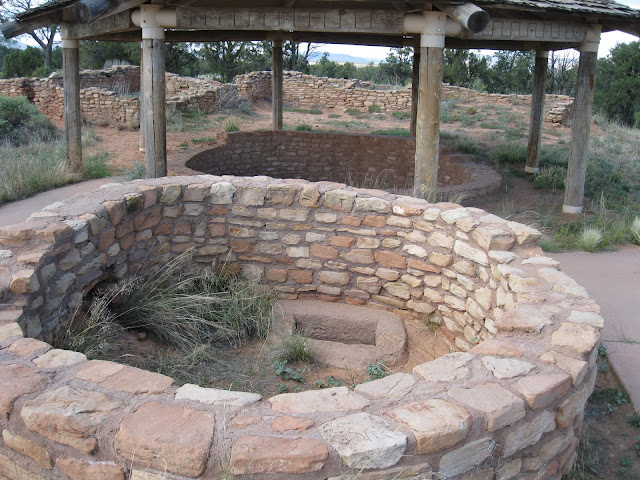 From the trail head the view west is to Comb Ridge, an 80 mile long sharp spined sandstone hogback that was a nearly impossible barrier to travel before the modern age. The east facing side is mostly the Navajo Sandstone layer.
From the trail head the view west is to Comb Ridge, an 80 mile long sharp spined sandstone hogback that was a nearly impossible barrier to travel before the modern age. The east facing side is mostly the Navajo Sandstone layer.The parking area here can also be used as a trail head for the Upper Butler Wash Trail that visits at least three ruins sites including the Ballroom Cave. Just inside the fence at the trail head an unnoticed and unmarked trail takes off to the right.
 The main trail crosses through high desert of sparse Pinon Pine and Utah Juniper trees with a lot of bare exposed rock. This trail is a short introduction to canyon and desert hiking and the desert environment.
The main trail crosses through high desert of sparse Pinon Pine and Utah Juniper trees with a lot of bare exposed rock. This trail is a short introduction to canyon and desert hiking and the desert environment. The trail ends at an overlook to the ruins, tucked under an alcove across a deep eroded canyon. At first glance it is one of those places where you wonder how did they get to that place.
The trail ends at an overlook to the ruins, tucked under an alcove across a deep eroded canyon. At first glance it is one of those places where you wonder how did they get to that place.
Not visible from the overlook is a modest sized arch or natural bridge at the head of the canyon. Move to the left about 100 feet or walk across the slick rock to the right about 100 yards. The ruins here are thought to have been built and occupied about 750 years ago and abandoned by 1300.
There is a good trail guide with markers on this trail, commenting on the geological layers visible here and identifying a dozen or so of the local plants. Some of the shrubs noted are Cliffrose, Threeleaf Sumac, Mountain Mahogany and Utah Serviceberry.
It took me about 30 minutes to make the round trip to the overlook but there is a lot to explore here. Look for the old trail also. There is an opening in the fence near the turn in, for access to explore the canyon below the ruins.







 The steep, narrow, twisty, gravel road that descends is called the Moki Dugway. It was constructed in 1958 by a mining company for transporting Uranium ore and drops 1100 feet in three miles.
The steep, narrow, twisty, gravel road that descends is called the Moki Dugway. It was constructed in 1958 by a mining company for transporting Uranium ore and drops 1100 feet in three miles.


 The San Juan River flows out of the San Juan Mountains in southwest Colorado and flows through the desert areas of the Four Corners area flowing west to meet with the waters of the Colorado River in Lake Powell.
The San Juan River flows out of the San Juan Mountains in southwest Colorado and flows through the desert areas of the Four Corners area flowing west to meet with the waters of the Colorado River in Lake Powell.


 The Valley of the Gods is a miniature of the nearby and more famous Monument Valley, and doesn't seem to get as much attention. No visitor center, gift shop, or bus loads of tourists.
The Valley of the Gods is a miniature of the nearby and more famous Monument Valley, and doesn't seem to get as much attention. No visitor center, gift shop, or bus loads of tourists.







